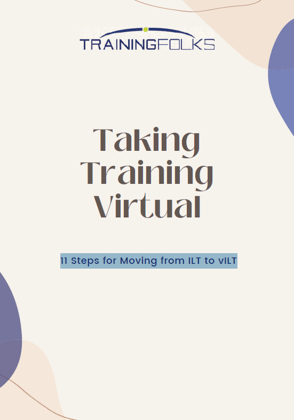Best Practices for Virtual Classroom Design

Virtual Classroom Design: Benefits at Every Level
The dramatic rise in remote work has shifted the business landscape, and we continue to see change as companies still define the future of work for their employees. Even though many have returned to the office, in many companies, workers are scattered around town, across the country, or even around the globe. Training is more important than ever for the new future of work.
Thanks to better internet connectivity and enhanced meeting platforms, online classrooms have undergone a major upgrade. Instructor led training (iLT) hasn’t been completely replaced by virtual instructor led training, or vILT. In fact, in the new future of work, many companies are utilizing one, the other, or a combination of both to achieve their training objectives.
Virtual tools abound, and much of the online learning experience is interactive. Breakout time, videos, on-screen annotation, participant voting, and real-time feedback keep things lively and engaging. Best of all, anyone anywhere can attend.
Here are more advantages to virtual classroom training:
• vILT classes are typically shorter than traditional in-person classes. Information is easier to retain, so training is more efficient
• vILT saves time and certain costs, such as travel or printing, associated with conventional training
• Classes can be recorded for students who aren’t able to attend live
• There are tools for measuring engagement and success
Best Practices for Virtual Classroom Design
The importance of thoughtful design can’t be overstated. Be sure to include the best practices below.
1. Personalization Is Power
Outstanding employees make good decisions on their own. At all levels, training should empower workers to think on their feet and trust their own judgment. Teamwork is an important goal, but great teams are made up of individuals who work well independently.
That’s why training should be as personalized as possible. Provide content that addresses the needs and pain points of everyone in attendance.
Many virtual instructor led training courses aim to accomplish goals, such as better use of time, more attendees who are more engaged, and a variety of useful content that is specific to the learner's needs.
2. Activities Must Suit the Subject Matter
Stay true to solid instructional design principles by resisting the temptation to use all the tools at your disposal. There are dozens of choices for in-class activities, but not all are beneficial for every course. It is crucial to focus on the students and their learning goals.
For example, infographics are effective for compliance and employee safety topics. Checklists are ideal for teaching company policy. If you’re rolling out a new product, simulations or how-to videos can work better.
In short, use the correct instructional design techniques and tools that meet your learning objectives and goals.
3. Engagement Is a Top Priority
Lack of participation can be a result of many factors, including, poor virtual classroom design.
Here are some suggestions to consider when building your program:
• Use warmth and a sense of humor to encourage participation. A funny story or icebreaker goes a long way to relieve tension and spark creativity
• Divide the time into digestible teaching segments. Between segments, encourage questions, personal stories, and feedback
• Use gamification or question-and-answer contests for good-natured competition
• Leverage the breakout function. Assign a problem, goal, or topic of discussion to groups of people in similar roles. Have each group appoint a spokesperson to share results with the large group
4. Don't Underestimate the Importance of a Facilitators Guide
vILT classes, just like iLT require a detailed facilitator guide. This is a key tool for creating consistency across the various classes being delivered, especially if multiple facilitators are delivering the same program to different audiences.
Train the trainer activities coupled with a solid facilitator guide will set your team up for success.
One last tip: If you have subject matter experts delivering your training classes, consider engaging contract virtual producers to assist in making it an even better virtual classroom experience.
Ready to get started with vILT, but not sure where to begin?
Get our FREE eBook Download:
'Taking Training Virtual: 11 Steps for Moving from iLT to vILT'


